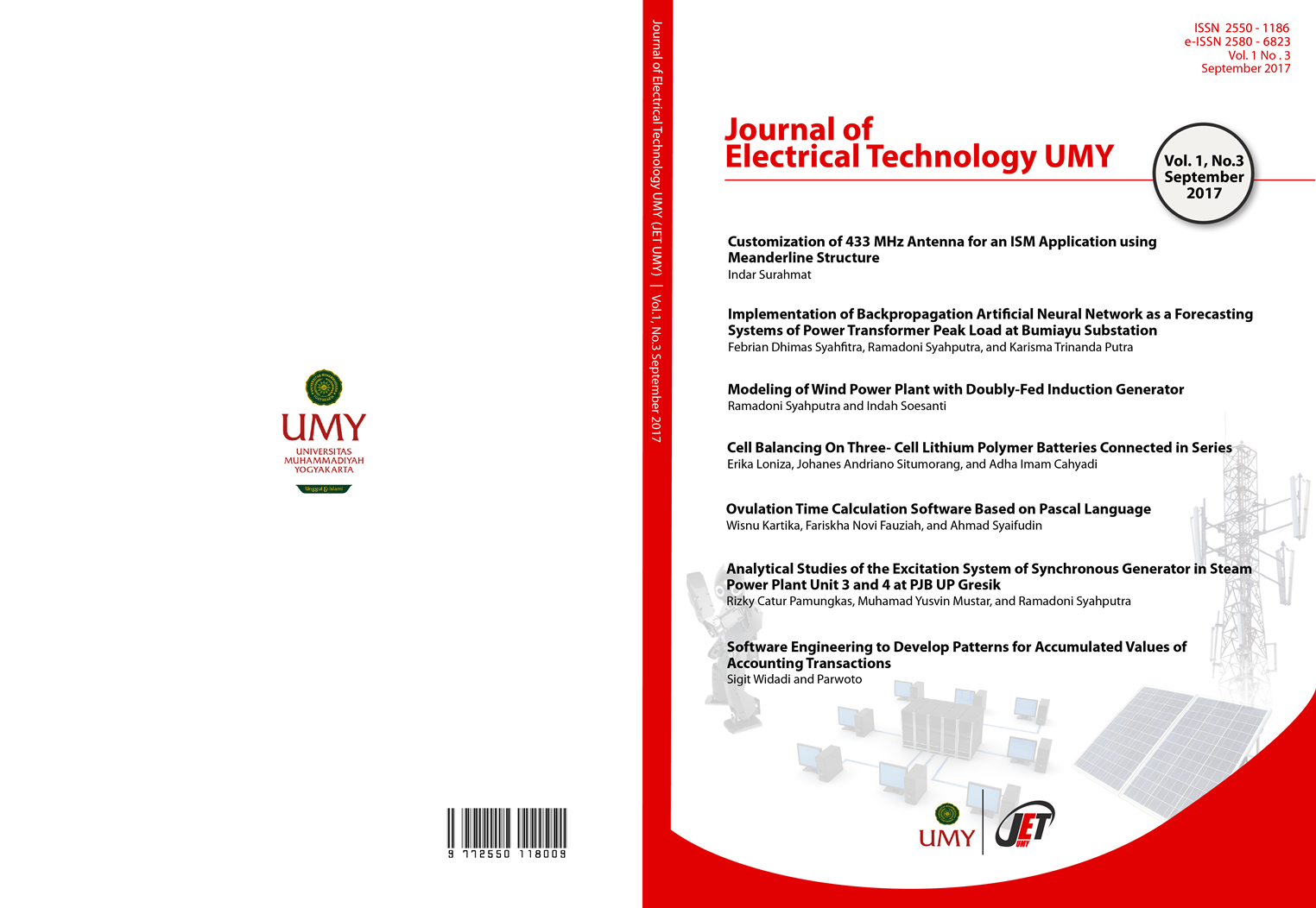Cell Balancing On Three- Cell Lithium Polymer Batteries Connected In Series
DOI:
https://doi.org/10.18196/jet.1318Keywords:
cell balancing, three cell lithium, passive balancingAbstract
Electric vehicle becomes popular recently, particularly in Indonesia. One of the most important and crucial components in an electrical vehicle is the battery. BMS (Battery Management System) is a system to monitor and regulate the performance of the battery resulting in effective-efficient-durable performance. Usually, BMS is needed to prevent battery from system failure. One of the problems that normally happens in a multi-cell battery and causing system failure is voltage unbalance. In this study, the system is designed so it can monitor the voltage condition of the three battery’s cells in series circuit and manage to balances it. The process of balancing the value of the voltage at the battery cells is known as cell balancing. The method used in this study is by using passive shunt resistor balancing method. In this method, an electronic circuit is designed in order to balance the value of the voltage at the battery cells using resistors to remove excess voltage. The result shows that the electrical circuit is capable to balance the voltage of each cell. Moreover, the designed circuit is monitored by software so it can perform in flexible manner.
References
B. C. Group, “Focus Batteries for Electric Cars.”
J. Q. YevgenBarsukov, “Cell-Balancing Techniques: Theory and Implementation 4.1,” in Battery Power Management for PortableDevices, 2013, pp. 111–138.
“Baterai.” [Online]. Available: https://id.wikipedia.org/wiki/Baterai. [Accessed: 15-Jun-2015].
W.-Y. Chang, “The State of Charge Estimating Methods for Battery: A Review,” 2013.
L. Lu, X. Han, J. Li, J. Hua dan M. Ouyang, “A review on the key issues for lithium-ion battery management in electric vehicles,” J.Power Sources, vol. 226, pp. 272–288, 2013.
M. Daowd, N. Omar, P. Van Den Bossche, and J. Van Mierlo, “Passive and active battery balancing comparison based on MATLAB simulation,” 2011 IEEE Veh. Power Propuls. Conf., pp. 1–7, Sep. 2011.
M. Daowd, N. Omar, P. Van Den Bossche, and J. Van Mierlo, “A Review of Passive and Active Battery Balancing based on MATLAB/Simulink,” vol. xx, no. September, 2011.
V. Siliconix, IRF540, SiHF540, no. V. 2012.
B. A. Pramana, “ESTIMASI STATE OF HEALTH (SOH) PADA BATERAI LITHIUMPOLYMER,” 2015.
Downloads
Published
How to Cite
Issue
Section
License
Copyright
The Authors submitting a manuscript do so on the understanding that if accepted for publication, copyright of the article shall be assigned to Journal of Electrical Technology UMY. Copyright encompasses rights to reproduce and deliver the article in all form and media, including reprints, photographs, microfilms, and any other similar reproductions, as well as translations.
Authors should sign Copyright Transfer Agreement when they have approved the final proofs sent by the journal prior the publication. JET UMY strives to ensure that no errors occur in the articles that have been published, both data errors and statements in the article.
JET UMY keep the rights to articles that have been published. Authors are permitted to disseminate published article by sharing the link of JET UMY website. Authors are allowed to use their works for any purposes deemed necessary without written permission from JET UMY with an acknowledgement of initial publication in this journal.
License
All articles published in JET UMY are licensed under a Creative Commons Attribution-ShareAlike 4.0 International (CC BY-SA) license. You are free to:
- Share — copy and redistribute the material in any medium or format
- Adapt — remix, transform, and build upon the material for any purpose, even commercially.
The licensor cannot revoke these freedoms as long as you follow the license terms. Under the following terms:
- Attribution — You must give appropriate credit, provide a link to the license, and indicate if changes were made. You may do so in any reasonable manner, but not in any way that suggests the licensor endorses you or your use.
- ShareAlike — If you remix, transform, or build upon the material, you must distribute your contributions under the same license as the original.
- No additional restrictions — You may not apply legal terms or technological measures that legally restrict others from doing anything the license permits.







